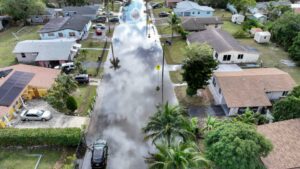Navigating the Intersection of Climate Change and Mortgage Lending
In today’s rapidly evolving real estate landscape, the implications of climate change are emerging as a critical factor in the mortgage lending arena. As climate disasters become more frequent, lenders are increasingly scrutinizing the environmental risks associated with properties before extending credit. At Extreme Investor Network, we believe it’s essential to stay ahead of these trends to safeguard your investments.
The Rising Influence of Climate on Creditworthiness
Gone are the days when lenders solely relied on traditional metrics like debt, income, and collateral. A recent report from First Street, a climate risk assessment firm, highlights a transformative shift: climate risk is now a crucial element in determining a borrower’s creditworthiness. Whether it’s flooding, wildfires, or severe winds, lenders are beginning to factor in these risks when assessing loan applications.
In fact, projections suggest that climate-driven foreclosures could lead to substantial losses—an alarming $1.21 billion in 2025, escalating to $5.36 billion in just a decade. This represents a staggering increase from 6.7% to nearly 30% of all foreclosure credit losses. As Jeremy Porter from First Street aptly stated, "Mortgage markets are now on the front lines of climate risk."
The Financial Fallout of Climate Events
Properties that experience flooding during extreme weather events often see a dramatic increase in foreclosure rates, averaging a 40% spike in affected neighborhoods. The implications are twofold: not only are homeowners burdened with immediate financial stress, but they may also be forced to abandon their properties—leaving lenders exposed to significant losses.
For consumers, particularly those in high-risk areas like Florida’s coastal zones, insurance premiums are skyrocketing due to volatile weather. The First Street report links soaring insurance costs directly to rising foreclosures, further complicating the financial landscape for both borrowers and lenders.
Lenders and Insurance: A Critical Gap
At present, while some lenders require flood insurance for properties in government-designated flood plains, this is not universally implemented. Notably, major entities like Fannie Mae, which plays a vital role in the mortgage market, have yet to integrate climate risk into their underwriting models effectively.
The consequences of inaction are becoming stark. Over the past four decades, the annual costs associated with climate-related disasters have surged by an astonishing 1,580%. This increase is attributed not only to the enhanced severity of storms but also to inflation, population growth, and ongoing real estate development in high-risk areas.
Preparing for Tomorrow’s Challenges
As investors, understanding the ramifications of these trends is essential. At Extreme Investor Network, we advocate for proactive strategies that consider these evolving risks. Here are a few actionable insights:
-
Diversify Investments: Consider properties in less vulnerable areas to mitigate risks associated with climate disasters.
-
Stay Informed: Keep abreast of new underwriting guidelines and insurance requirements, which may shift as lenders adapt to climate risk.
-
Incorporate Sustainability: Investing in energy-efficient and resilient properties can not only lower operating costs but also enhance property value over time.
- Advocate for Change: Engage with industry stakeholders on the importance of integrating climate risk into lending practices to create a more stable real estate market.
Conclusion
As the financial impacts of climate change manifest more prominently in the mortgage sector, the landscape is rapidly evolving. By acknowledging and adapting to these changes, investors can safeguard their financial futures. Join us at Extreme Investor Network as we navigate the complexities of climate risk in real estate investment and empower investors to make informed decisions for tomorrow.
Stay tuned for more insights and strategies designed to help you thrive in a changing marketplace.

